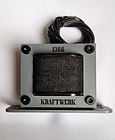
INPUT TRANSFORMERS
OUTPUT-BRIDGING TRANSFORMERS
BUNDLES-SETS
Review of the Kraftwerk 1201 DI Transformer — Passive and Active Configuration
Harry Brehm, Rottweil (DE)

Passive Configuration:
I tested the 1201 in passive DI mode, with both primaries and both secondaries connected in series. It was compared directly with a Palmer PAN01 and a Sowter 4243, using a 5-string bass guitar (from low B to high G). The Palmer was quickly ruled out—it lacked the openness and clarity of the 1201 and the 4243.
The 1201 delivered a very balanced frequency response from top to bottom. The low end was full and defined without being muddy, while the highs were clean and open. The entire signal had a sense of clarity and musical weight. What stood out was the way the 1201 handled higher notes on the fretboard—they remained full and rich, much like the sound of a REDDI active tube DI.
I also tried a configuration with only one primary and both secondaries in series, which produced a louder, deeper, and punchier low end with a fast transient response and a subtle growl. This was my favorite setup.
Compared to the Sowter, the 1201 had about 3 dB less output in passive mode, but that was easily adjusted on the mixer. Overall, this transformer doesn’t just look and feel high-end—it sounds that way too. For bass DI applications, I personally prefer the 1201 over the Sowter 4243.
Active Configuration:
In active mode, I placed the 1201 at the end of a simple tube circuit. The same 5-string bass signal was used, and again it was compared to the Sowter 4243. This time, no gain correction was needed—the output levels of both transformers were nearly identical.
The 1201 retained all the great qualities from the passive test—clear top-end, defined mids—but the bass became even deeper, more controlled, and authoritative. When pushed harder, it produced a smooth, pleasing low-end growl along with a subtle compression that made the playing experience feel more expressive and enjoyable.
Even under high input levels, the transformer kept its sense of air and openness—no harshness or collapse in the treble, and the mids stayed smooth, rich, and harmonically pleasing. Using one primary and both secondaries in series again gave a stronger output without compromising character.
While the Sowter 4243 is a well-known, high-quality DI transformer, the 1201 had noticeably more punch and “muscle” in direct comparison—an excellent trait for bass DI use.
Conclusion:
The Kraftwerk 1201 DI transformer is exceptionally capable, both in passive and active use. It offers clarity, power, and tonal richness that compete with (and in some ways surpass) established names like Sowter and Jensen. In my setup, particularly for bass guitar, it came out on top. I'm excited for its official release and would be happy to recommend it to others in the bass community, including on forums like bassic.de.
Great work, Goran—this is an outstanding piece of gear!
Review of the Kraftwerk 1366 Set
Salzburg, Wohlklang Audio Mastering Studio

Hi Goran,
It took us a bit to find the right spot for the 1366 in our mastering chain, considering impedance, functionality, and sonic impact — but once dialed in, it became a real pleasure to use!
The build quality is excellent, and the sound is just as impressive. It keeps the low end tight, yet adds that beautiful transformer coloration when pushed — with a wide sweet spot before any degradation sets in, which makes it very usable for mastering.
We’ll continue testing it in the coming weeks, but so far, we can say: it’s a great product with professional service. We really like it and would gladly recommend it.
Looking forward to seeing your idea of a mastering rack with switchable transformers come to life — that would be very cool!
All the best from Salzburg,
Wohlklang Audio
Mastering Studio
Review of the Kraftwerk 1166 VT
Andrew Carpenter (Subliminal Spectrum)

After installing the 1166VT in my Heritage TT-73, the improvement was immediate — the unit simply sounds more alive and musical than before. I wasn’t expecting such a clear step up, but it quickly became obvious in use. It’s rare to find a transformer upgrade that delivers this much character and quality.
Review of the Kraftwerk M600 ST + 1366 ST
Heinke Aussenegg (Mastering Engineer Wohlklang Audio)
_edited.jpg)

I have done some work with it since they arrived. Both are great! 1366 a bit more I would say "midrange pronounced" in a musical way. 600STs is more even, balanced, clean and stable. But everything in a very subtle way. Bass always stayes very clean although it gets the little weight which is desired. Stood it's ground against the Manley Varimu v4. I prefer the 600ST because it stays more clean in the bass than Manley. Will often depend on the music and taste but high class anyway.
So thank you again for your work and service!
Wonder what Bob Katz has to say on them...
Have a nice time and all the best!
Heinke Aussenegg,
Mastering Engineer
Wohlklang Audio

Subscribe to our newsletter to recieve the latest offers, deals and news.
.png)




















